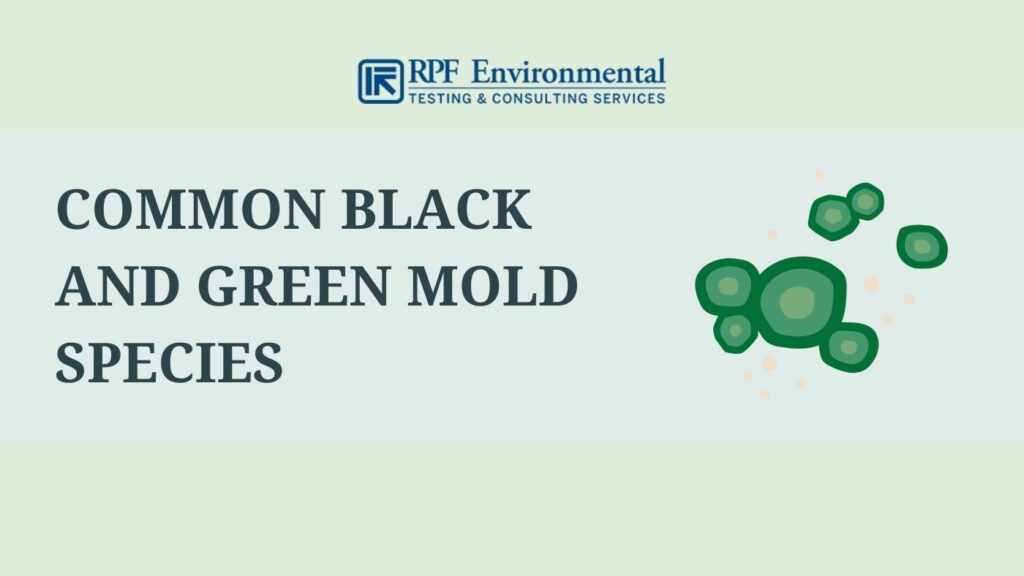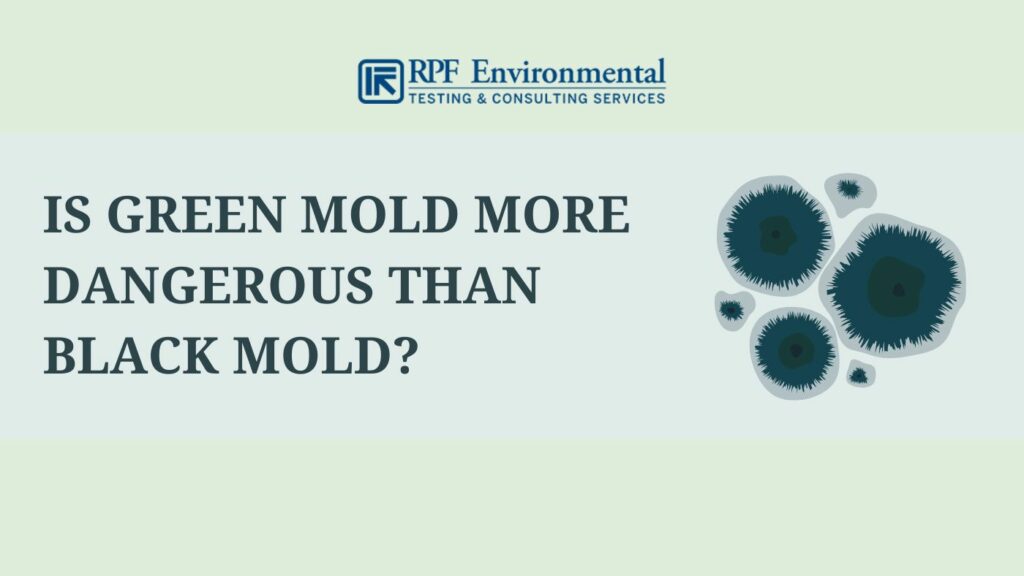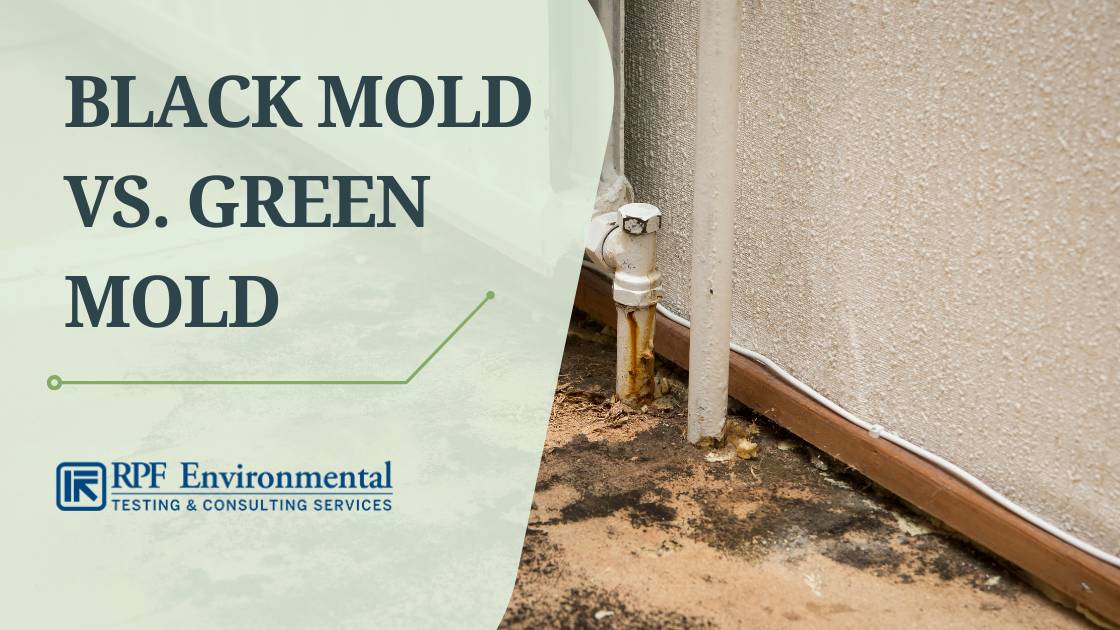If you want to know what color of mold is more dangerous or if mold color really matters when it comes to their toxicity, you’ve come to the right place!
While both black and green mold can cause serious health risks, they are two different types of fungi. In this blog, we will look at the differences between these two. We will also discuss the health risks associated with each, as well as how to identify them. Thus, helping you make an informed decision on how to address mold infestation in your home or business properly and safely.

RPF Environmental provides mold testing services in the New England region including New Hampshire, Maine, and Massachusetts. We can help you with mold color identification in your home or business. Book a consultation now!
What is Green Mold?
Green mold is the most common color of mold you can find in homes. It refers to numerous fungi with a greenish hue from bright green to dark-colored ones. They appear soft and powdery and they are commonly found on foods like bread and fruits. But because green mold is a very common color, this doesn’t mean that all green spots you see on surfaces are mold. Testing is the only way to confirm if you are dealing with mold contamination or not.
What is Black Mold?
Black mold is considered toxic, but not all types are. The most popular type of toxic mold is Stachybotrys chartarum which releases mycotoxins that can cause severe health complications like cancer and immune deficiency. This is why it is crucial that toxic mold be removed as soon as possible, but we recommend letting a professional handle the remediation.
Common Black and Green Mold Species

Below are the common types of green and black mold to help differentiate the two:
Types of Green Mold
There are many fungi that are referred to as green mold, but the three common ones are Aspergillus, Cladosporium, and Penicillium. Take note though that these molds don’t always have greenish spores. They can come in black, blue, and other colors.
1. Aspergillus
- Most species in this genus produce greenish spores and are often found in highly oxygenated areas and spoiled food.
- They prefer growing on starchy foods like bread.
2. Cladosporium
- This has an olive green color and thrives mostly on plants.
- Spores are commonly airborne and can also be found on walls, carpets, insulation, cabinets, and other surfaces prone to moisture.
3. Penicillium
- Bluish-green in color and produces penicillin – a popular antibiotic used in treating bacterial infections
- This mold prefers cool environments such as soil.
Types of Black Mold
As for black molds, here are the widely known types of fungi:
1. Aspergillus
- A few species of Aspergillus, like Aspergillus niger, come in black colors and are common in fruits like grapes, onions, and apricots.
- This is a toxic mold that causes aspergillosis and severe health complications in immunocompromised people.
2. Alternaria
- This airborne mold can grow into thick black, gray, or green colonies.
- It predominantly thrives outdoors but can travel inside your home or business and grow on wood and plants.
3. Cladosporium
- Cladosporium is commonly found outdoors on dead plants and trees but can also grow on carpets, furniture, attics, basements, and other areas once it finds its way into your home.
- It can also come in clusters of green and yellow spots.
4. Stachybotrys
- Stachybotrys chartarum is the widely known fungi associated with black mold. It can come in black or greenish-black colors.
- It is among the top most hazardous fungi and is found mostly in food, wood, and leaky areas.
Read a more detailed discussion on the types of house mold and where mold is found in homes in these blogs.
Is Green Mold More Dangerous Than Black Mold?

Many people believe that black mold is the most harmful type of mold that can affect both humans and pets. However, green molds can be as dangerous as black molds, especially to people with existing health issues.
All colors of mold can be harmful and continuous exposure can trigger allergens and asthma attacks. Worse cases involve severe respiratory infections and organ damage. So regardless if you’re dealing with black, green, or other mold colors, you need to address it as soon as possible.
Mold Myths: Other Things You Need to Know About Mold Color
Below are some of the top myths about mold color that you might want to know:
Only black mold is toxic.
Though black mold is known to be toxic, the color of the mold is irrelevant to the level of toxicity of the mold. Black mold can produce toxic mycotoxins, and so can some species of green mold. In fact, not all black molds produce mycotoxins. Thus, assessing mold toxicity based on color will result in incorrect conclusions.
All molds are black.
Mold can also be green, white, blue, brown, pink, or even a combination of various colors. Also, mold can have different colors based on the environmental conditions and can change through time.
FAQs
Black and green mold cover different species of mold, but their color isn’t always a reliable basis to determine their toxicity because they can change over time. Their appearance may differ, but they are both harmful to your health and need to be removed once detected to prevent the situation from getting worse.
Conclusion
Color is not a reliable basis for assessing how dangerous mold is. No matter what the color of mold is in your home, black or green, both can cause severe health complications and should be addressed immediately. However, you can prevent both types of mold by fixing moisture problems in your home. Also, contacting a professional is best if you are not sure how to deal with black or green mold contamination.
Contact RPF Environmental for expert mold inspection services in New Hampshire, Maine, Massachusetts, and other areas across the nation. We also cater to the needs of healthcare industries, school facilities, businesses, and more!




